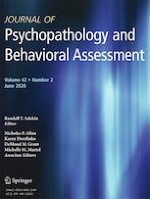21-12-2019
Interpretability and Validity of a Bifactor Model of ADHD in Young Adults: Assessing the General “g” and Specific IA and HI Factors
Gepubliceerd in: Journal of Psychopathology and Behavioral Assessment | Uitgave 2/2020
Log in om toegang te krijgenAbstract
The current study investigated the clinical utility and validity of a bifactor model for representing ADHD symptoms in young adults. Two-hundred and seventy-eight participants (33.8% male) aged 18–24 and informants completed well-validated measures of ADHD symptoms and internalizing and externalizing behaviors. Results across self- and informant-report methods suggested a bifactor model with inattentive and hyperactive/impulsive specific factors as the best fitting conceptualization of ADHD symptoms. Within this bifactor model, the general (“g”) factor was found to be an interpretable representation of most ADHD symptoms that demonstrated significant associations with several internalizing and externalizing behaviors. Over and above “g,” inattentive and hyperactive/impulsive specific factors appeared to account for unique information in ADHD symptoms, particularly those corresponding with difficulties following through on instructions and verbal impulsivity, respectively. Specific factors also appeared to account for unique information pertaining to anxious/depressed and intrusive behavioral dysfunction, over and above either “g” or total ADHD symptom count scores. Overall, results suggested that integration of different components of the bifactor model, particularly HI, into clinical practice may help parse heterogeneity in ADHD-related phenotypes during young adulthood.
